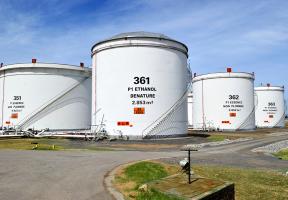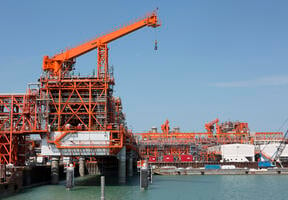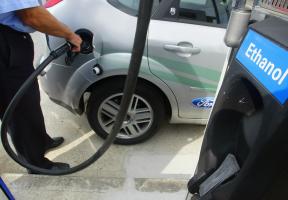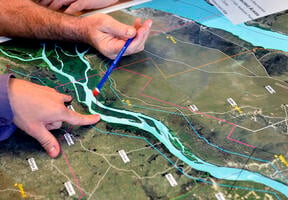How Does Cogeneration Work?
5 min read
, or combined and (CHP), is the simultaneous production and use of thermal energy – in other words, heat – and , which is usually converted into . The advantage of this technology is that it optimizes a plant’s efficiency by recovering the heat instead of releasing it into the environment.

© JEAN-FRANCOIS MONIER / AFP - The two gas-fired boilers in the district heating network in Le Mans, western France, provide heat to supplement production from the waste incineration plant, which also generates electricity.
Cogeneration and Micro-CHP
Cogeneration first came about in the 1950s, when manufacturing plants such as sugar refineries and paper mills, which produced and consumed a great deal of heat, began to use their steam discharge to generate electricity.
Today, cogeneration plants are often installed in order to produce primarily electricity, using fossil fuels (generally natural gas), or energy. The heat generated from these operations can then be captured and used in urban heating networks and industrial processes.
The applications can vary considerably. Some of the equipment is quite small, such as compact modules powered by gas to produce hot water and heat for offices and apartment buildings, as well as locally generated electricity. Modules with a power output of less than 36 kilowatts-electric (kWe) are classed as micro CHP and those with an output between 36 and 250 kWe are classed as mini-CHP.
Different Industrial Uses
Other applications are on the industrial scale, as shown in the examples below.
Example of a Paper Mill: The Biganos Biomass Cogeneration Plant
The Cellulose du Pin paper mill in Biganos in southwestern France processes large quantities of wood, which leaves residue and branches at its disposal. This biomass, which cannot be used for paper, is burned in a large boiler (40 meters high) and produces very hot, high-pressure steam, at over 500°C and 120 bar.
The steam powers turbo generators . The electricity they produce is either consumed on-site or sold to the public grid. The expanded steam, discharged from the turbine at a lower temperature, is recovered and used to dry the paper.
Example of a Plastics Factory: Ineos Polymers in Sarralbe
This plastics factory consumes heat and electricity in large quantities, making it cost effective to install a gas-fired cogeneration engine. The engine produces electricity for the factory and the excess is sold. A water circuit at 75°C from the factory passes through the cogeneration unit, cools the engine, recovers the heat from the exhaust gases, and returns to the factory at 105°C.
Example of a District Heating Network: Le Mans
In late 2018, the French city of Le Mans doubled the size of its district heating network, which is powered by a waste plant, by reducing the electricity-producing section and recovering the excess heat that was being discharged into the air. The city also built a new unit consisting of two gas-fired boilers to support the incineration plant by providing heat to offset dips in output. On average, the boilers provide 16% of the heat.
Combined Cycle Gas Turbine Power Plants
See EDF animation (in French).
In France, gas-fired thermal power plants have gradually replaced fuel-oil- and -fired models. The new-generation facilities are themselves evolving into combined cycle gas turbine (CCGT) power plants.
CCGT plants are based on a simple principle (see diagram below):
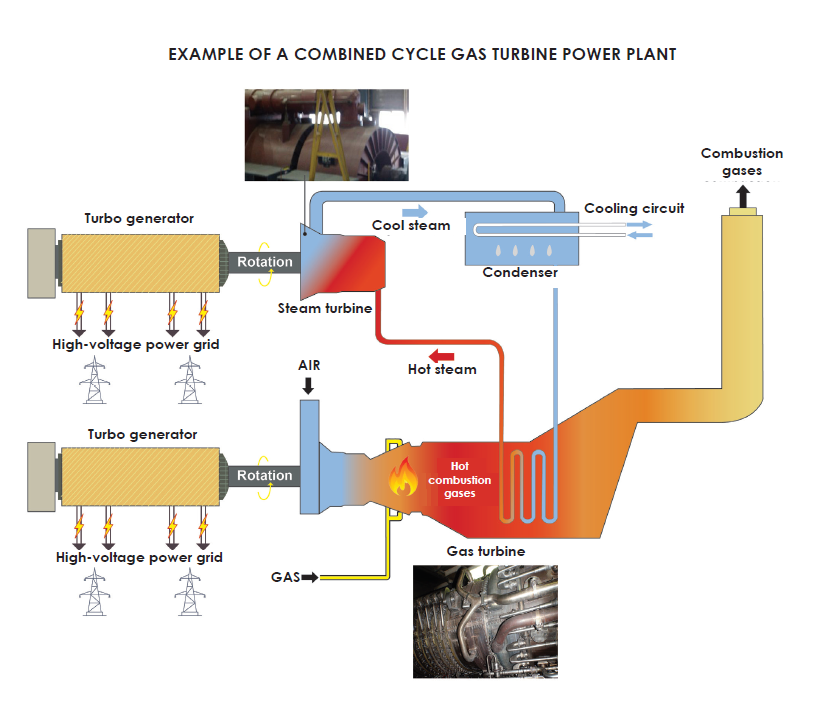
- The plants combine a gas turbine, also known as a combustion turbine, with a steam turbine, both of which are connected to a turbo generator.
- The gas turbine, which works like a jet engine, drives the turbo generator to produce electricity.
- The combustion gases, which are very hot, are recovered and used to heat water in a boiler.
- The water generates steam that passes through the steam turbine.
- The steam turbine in turn drives the turbo generator.
Thanks to this double generation, the CCGT plant’s efficiency is much higher than that of a standard gas-fired power plant, amounting to as much as 70%, compared with 35%. In addition, a CCGT facility emits around half as much CO2 as a coal-fired power plant.

